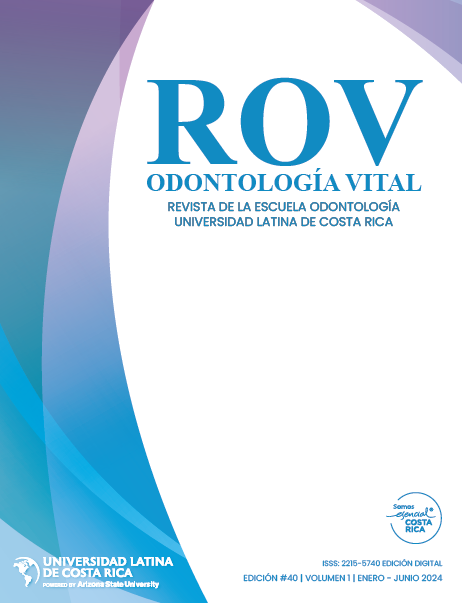Perception of quality of life and satisfaction in patients with removable partial dentures
DOI:
https://doi.org/10.59334/ROV.v1i40.562Keywords:
Perception, Quality of life, Partial denture, Removable, SatisfactionAbstract
Introduction: Various authors mention that correct planning of a removable partial denture can offer adequate satisfaction in terms of aesthetics and function. In cases where aesthetics is a priority, a design without visible clasps is proposed. In addition, this elaboration does not demand higher costs, if the practitioner reaches the corresponding diagnosis and establishes the most convenient design for each specific case. Objective: The objective was to carry out a systematic review on the perception of quality of life and satisfaction in patients with removable partial dentures. Materials and methods: Thirteen scientific articles were included using the PRISMA methodology for the identification, review and inclusion of the texts that were part of this study. The articles were selected considering the title, abstract and objective. Systematic reviews, meta-analyses, comparative studies, and literature reviews that included criteria about satisfaction in patients with removable partial dentures where evaluated. The articles were read in their entirety: the objectives, methodology and conclusions of each one of them were analyzed. Results: The most common complaint was the aesthetic result, followed by pain during chewing. It is recommended to offer periodic control of the removable partial denture to evaluate its correct functioning and fit. Conclusion: The success of the treatment with removable partial dentures can be evaluated through the precise diagnosis of the case, considering previous experiences and taking into account the expectations of the patient. Also, understanding the patient’s lifestyle, socioeconomic level, periodontal health status, and personality, may be factors that allow the practitioner to reduce the risk of future failure for the treatment with removable partial dentures.
Downloads
References
Aljabri, M. K., Ibrahim, T. O., & Sharka, R. M. (2017). Removable partial dentures: Patient satisfaction and complaints in Makkah City, KSA. Journal of Taibah University Medical Sciences, 12(6), 561-564. https://doi.org/10.1016/j.jtumed.2017.03.002
AL-Omiri, M. K., Sghaireen, M. G., Al-Qudah, A. A., Hammad, O. A., Lynch, C. D., & Lynch, E. (2014). Relationship between impacts of removable prosthodontic rehabilitation on daily living, satisfaction and personality profiles. Journal of Dentistry, 42(3), 366-372. https://doi.org/10.1016/j.jdent.2013.12.010
Campbell, S. D., Cooper, L., Craddock, H., Hyde, T. P., Nattress, B., Pavitt, S. H., & Seymour, D. W. (2017). Removable partial dentures: The clinical need for innovation. The Journal of Prosthetic Dentistry, 118(3), 273-280. https://doi.org/10.1016/j.prosdent.2017.01.008
Čelebić, A., & Knezović-Zlatarić, D. (2003). A comparison of patient's satisfaction between complete and partial removable denture wearers. Journal of Dentistry, 31(7), 445-451. https://doi.org/10.1016/s0300-5712(03)00094-0
Fenlon, M. R., & Sherriff, M. (2008). An investigation of factors influencing patients' satisfaction with new complete dentures using structural equation modelling. Journal of Dentistry, 36(6), 427-434. https://doi.org/10.1016/j.jdent.2008.02.016
Frank, R. P., Milgrom, P., Leroux, B. G., & Hawkins, N. R. (1998). Treatment outcomes with mandibular removable partial dentures: A population-based study of patient satisfaction. The Journal of Prosthetic Dentistry, 80(1), 36-45. https://doi.org/10.1016/s0022-3913(98)70089-7
Jacobson, T. E. (1982). Satisfying Esthetic Demands with Rotational Path Partial Dentures. The Journal of the American Dental Association, 105(3), 460-465. https://doi.org/10.14219/jada.archive.1982.0346
Knezović, D., Čelebić, A., Valentić-Peruzović, M., Jerolimov, V., & Pandurić, J. (2003). A survey of treatment outcomes with removable partial dentures. Journal of Oral Rehabilitation, 30(8), 847-854. https://doi.org/10.1046/j.1365-2842.2003.01039.x
Mazurat, N., Mazurat, R. (2003) Discuss Before Fabricating: Communicating the Realities of Partial Denture Therapy. Part I: Patient Expectations. PMID: 12559057 http://www.cda-adc.ca/jcda/vol-69/issue-2/90.pdf
Shala, K. S., Dula, L. J., Pustina-Krasniqi, T., Bicaj, T., Ahmedi, E. F., Lila-Krasniqi, Z., & Tmava-Dragusha, A. (2016). Patient's Satisfaction with Removable Partial Dentures: A Retrospective Case Series. The Open Dentistry Journal, 10(1), 656-663. https://doi.org/10.2174/1874210601610010656
Siqueira, G. P. D., dos Santos, M. B. F., Santos, J. F. F. D., & Marchini, L. (2012). Patients' expectation and satisfaction with removable dental prosthesis therapy and correlation with patients' evaluation of the dentists. Acta Odontologica Scandinavica, 71(1), 210-214. https://doi.org/10.3109/00016357.2012.654612
Suh, J. S., & Billy, E. J. (2008). Rotational Path Removable Partial Denture (RPD): Conservative Esthetic Treatment Option for the Edentulous Mandibular Anterior Region: A Case Report. Journal of Esthetic and Restorative Dentistry, 20(2), 98-105. https://doi.org/10.1111/j.1708-824
Published
How to Cite
License
Copyright (c) 2024 Ana Isabel Rios López, Dante Alcántara Chávez

This work is licensed under a Creative Commons Attribution 4.0 International License.
Authors who publish with Odontología Vital agree to the following terms:
- Authors retain the copyright and grant Universidad Latina de Costa Rica the right of first publication, with the work simultaneously licensed under a Creative Commons Attribution 4.0 International license (CC BY 4.0) that allows others to share the work with an acknowledgement of the work's authorship and initial publication in this journal.
- Authors are able to enter into separate, additional contractual arrangements for the non-exclusive distribution of the Odontología Vital's published version of the work (e.g., post it to an institutional repository or publish it in a book), with an acknowledgement of its initial publication.
- Authors are permitted and encouraged to post their work online (e.g., in institutional repositories or on their website) prior to and during the submission process, as it can lead to productive exchanges, as well as earlier and greater citation of published work.
Métricas alternativas











